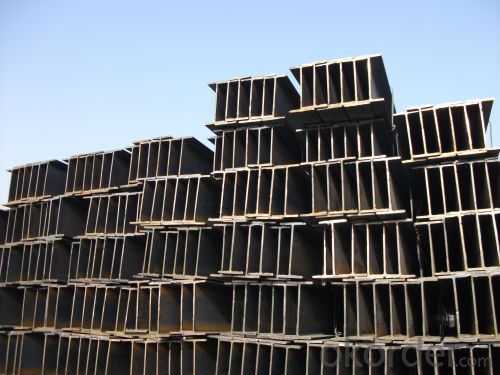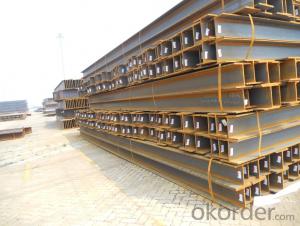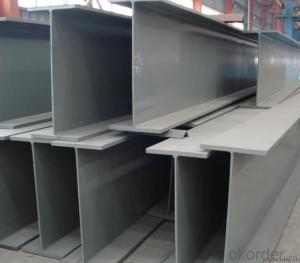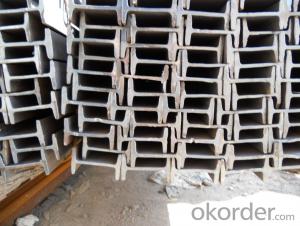Hot Rolled Steel H-Beam for Structure Steel
- Loading Port:
- Tianjin
- Payment Terms:
- TT OR LC
- Min Order Qty:
- 30000 m.t.
- Supply Capability:
- 150000 m.t./month
OKorder Service Pledge
OKorder Financial Service
You Might Also Like
Item specifice
Product Description:
Product Description:
OKorder is offering Hot Rolled Steel H-Beam for Structure Steel at great prices with worldwide shipping. Our supplier is a world-class manufacturer of steel, with our products utilized the world over. OKorder annually supplies products to European, North American and Asian markets. We provide quotations within 24 hours of receiving an inquiry and guarantee competitive prices.
Product Applications:
Hot Rolled Steel H-Beam for Structure Steel are ideal for structural applications and are widely used in the construction of buildings and bridges, and the manufacturing, petrochemical, and transportation industries.
Product Advantages:
OKorder's Hot Rolled Steel H-Beam for Structure Steel are durable, strong, and resist corrosion.
Main Product Features:
· Premium quality
· Prompt delivery & seaworthy packing (30 days after receiving deposit)
· Corrosion resistance
· Can be recycled and reused
· Mill test certification
· Professional Service
· Competitive pricing
Product Specifications:
Specifications of Hot Rolled Steel H-Beam for Structure Steel
1. Standard: GB700-88, Q235B2.
2. Grade: Q235, SS400 or Equivalent
3. Length: 6m,10m, 12m as following table
4. Invoicing on theoretical weight or actual weight as customer request
5.Payment: TT or L/C
6. Sizes:
SIZE(mm) | DIMENSION(kg/m) |
100*100 | 16.9 |
125*125 | 23.6 |
150*75 | 14 |
150*150 | 31.1 |
148*100 | 20.7 |
198*99 | 17.8 |
200*100 | 20.9 |
248*124 | 25.1 |
250*125 | 29 |
Usage & Applications of Hot Rolled Steel H-Beam for Structure Steel
Commercial building structure ;Pre-engineered buildings; Machinery support structure; Prefabricated structure; Medium scale bridges; Ship-building structure. etc.
Packaging & Delivery of Hot Rolled Structural Steel H Beam
1. Packing: it is nude packed in bundles by steel wire rod
2. Bundle weight: not more than 3.5MT for bulk vessel; less than 3 MT for container load
3. Marks:
Color marking: There will be color marking on both end of the bundle for the cargo delivered by bulk vessel. That makes it easily to distinguish at the destination port.
Tag mark: there will be tag mark tied up on the bundles. The information usually including supplier logo and name, product name, made in China, shipping marks and other information request by the customer.
If loading by container the marking is not needed, but we will prepare it as customer request.
4. Transportation: the goods are delivered by truck from mill to loading port, the maximum quantity can be loaded is around 40MTs by each truck. If the order quantity cannot reach the full truck loaded, the transportation cost per ton will be little higher than full load.
5. Delivered by container or bulk vessel
Production flow of Hot Rolled Structural Steel H Beam
Material prepare (billet) —heat up—rough rolling—precision rolling—cooling—packing—storage and transportation
FAQ:
Q1: Why buy Materials & Equipment from OKorder.com?
A1: All products offered byOKorder.com are carefully selected from China's most reliable manufacturing enterprises. Through its ISO certifications, OKorder.com adheres to the highest standards and a commitment to supply chain safety and customer satisfaction.
Q2: How do we guarantee the quality of our products?
A2: We have established an advanced quality management system which conducts strict quality tests at every step, from raw materials to the final product. At the same time, we provide extensive follow-up service assurances as required.
Q3: How soon can we receive the product after purchase?
A3: Within three days of placing an order, we will begin production. The specific shipping date is dependent upon international and government factors, but is typically 7 to 10 workdays.
Q4: What makes stainless steel stainless?
A4: Stainless steel must contain at least 10.5 % chromium. It is this element that reacts with the oxygen in the air to form a complex chrome-oxide surface layer that is invisible but strong enough to prevent further oxygen from "staining" (rusting) the surface. Higher levels of chromium and the addition of other alloying elements such as nickel and molybdenum enhance this surface layer and improve the corrosion resistance of the stainless material.
Images:


- Q:What are the different fabrication methods for steel H-beams?
- There are several different fabrication methods used for manufacturing steel H-beams. These methods include hot rolling, cold rolling, and welding. Hot rolling is the most common method used for fabricating steel H-beams. In this process, a billet of steel is heated to a high temperature and then passed through a series of rolling stands to shape it into the desired H-beam profile. The high temperature makes the steel more malleable, allowing it to be easily formed into the H-shape. This method results in high-quality H-beams with excellent structural integrity. Cold rolling is another fabrication method used for steel H-beams. In this process, the steel is passed through a series of rolling stands at room temperature. The cold rolling process helps to improve the surface finish and dimensional accuracy of the H-beams. It is often used for producing smaller and lighter H-beams, which are commonly used in applications where weight and size are critical factors. Welding is also used for fabricating steel H-beams. In this method, individual steel plates or sections are welded together to form the H-beam shape. Welding allows for greater flexibility in terms of the size and shape of the H-beam, making it suitable for custom or non-standard applications. However, welded H-beams may have lower structural integrity compared to those produced through hot or cold rolling. Overall, the choice of fabrication method for steel H-beams depends on various factors, including the size, shape, and application requirements. Each method has its own advantages and limitations, and manufacturers carefully select the most suitable method based on the specific needs of the project.
- Q:How do steel H-beams perform in areas with high snow loads?
- Areas with high snow loads benefit greatly from the performance of steel H-beams. The unique shape and design of these beams enable them to evenly distribute the weight of the snow, preventing any sagging or structural damage. The horizontal flanges located at the top and bottom of the H-beams offer exceptional load-bearing capabilities, ensuring that the beams can withstand heavy snow loads without buckling or collapsing. Moreover, steel H-beams possess exceptional durability and corrosion resistance, making them an ideal choice for regions with severe winter conditions. In summary, steel H-beams offer reliability and sturdiness for areas with high snow loads, providing both structural stability and peace of mind.
- Q:What is the maximum length of a steel H-beam that can be manufactured?
- The maximum length of a steel H-beam that can be manufactured depends on several factors including the manufacturing process, transportation restrictions, and practical limitations. In terms of the manufacturing process, steel H-beams are typically produced in standard lengths that can vary depending on the specific steel mill or manufacturer. These standard lengths often range from 20 to 60 feet (6 to 18 meters). However, it is important to note that longer lengths can often be custom ordered or fabricated based on specific project requirements. Transportation restrictions also play a significant role in determining the maximum length of a steel H-beam. The length of the beam must be able to fit within the constraints of transportation methods such as trucks, trains, or ships. These transportation methods have their own size limitations, and exceeding these limits may require special arrangements, permits, or even partial disassembly of the beam. Lastly, practical limitations must be considered when determining the maximum length of a steel H-beam. Longer beams can become more challenging to handle, maneuver, and install on construction sites. The weight and size of the beam can make it more difficult to transport and lift into place, potentially requiring specialized equipment or additional manpower. In conclusion, while there are standard lengths for steel H-beams, the maximum length that can be manufactured is influenced by the manufacturing process, transportation restrictions, and practical considerations. Custom orders, transportation logistics, and practical limitations all play a role in determining the maximum length of a steel H-beam.
- Q:Can steel H-beams be used for elevated walkways?
- Yes, steel H-beams can be used for elevated walkways. Steel H-beams are commonly used in construction for their strength and load-bearing capabilities, making them suitable for supporting walkways at elevated heights.
- Q:Can steel H-beams be used for railway stations?
- Yes, steel H-beams can be used for railway stations. They are commonly used in the construction of railway station platforms, bridges, and other infrastructure due to their high strength, durability, and ability to support heavy loads.
- Q:How do steel H-beams compare to concrete beams in terms of construction speed?
- Steel H-beams are generally faster to construct compared to concrete beams. This is primarily due to the lighter weight of steel beams, which allows for easier transportation and installation. Steel beams can be prefabricated off-site, reducing on-site construction time. In contrast, concrete beams require more time for formwork, curing, and other construction processes. Overall, steel H-beams offer a quicker construction process, making them a popular choice in many construction projects.
- Q:Are steel H-beams suitable for structures with long cantilevers?
- Structures with long cantilevers can indeed benefit from the use of steel H-beams. H-beams are renowned for their impressive strength-to-weight ratio, making them an optimal choice for supporting heavy loads across extensive distances. They possess exceptional structural stability and can withstand considerable bending moments and shear forces, which are crucial prerequisites for cantilever structures. The design of H-beams ensures the even distribution of weight and load throughout their structure, thereby guaranteeing the stability and security of the cantilevered section. The deep profile of H-beams facilitates efficient weight distribution, thereby minimizing the risk of structural failure or deflection. Furthermore, steel H-beams possess remarkable durability and corrosion resistance, rendering them suitable for outdoor or exposed applications. They can endure extreme weather conditions and maintain their structural integrity over time. Moreover, steel is an immensely versatile material that can be easily fabricated and tailored to meet specific project requirements. H-beams can be cut, welded, and joined to form various shapes and sizes, accommodating the precise dimensions and load-bearing needs of the cantilever structure. In conclusion, steel H-beams provide the essential strength, stability, and durability necessary for structures featuring long cantilevers.
- Q:Can steel H-beams be used in mezzanine construction?
- Certainly, mezzanine construction often incorporates steel H-beams, owing to their robustness and capacity to withstand substantial loads. Their structural integrity and durability render them an excellent selection for establishing a sturdy foundation for mezzanine floors. Moreover, their adaptability permits diverse design possibilities, rendering them suitable for a range of mezzanine construction ventures.
- Q:What are the specifications for H steel HW, HB, HN?
- HW is a H type steel flange height and width substantially equal; mainly used for reinforced concrete frame column steel column, also known as rigid steel column; column is mainly used in steel structure.
- Q:What is the purpose of using H-beams?
- H-beams, also known as I-beams or universal beams, serve a crucial purpose in the construction industry. The primary purpose of using H-beams is to provide structural support and strength to various structures, including buildings, bridges, and other infrastructure projects. One of the key advantages of H-beams is their unique shape, which resembles the letter "H" when viewed from the cross-section. This design allows H-beams to distribute weight evenly and efficiently, making them ideal for carrying heavy loads and resisting bending or deflection. The top and bottom flanges of the beam provide resistance against compressive and tensile forces, while the web in between ensures stability and prevents buckling. The purpose of using H-beams is to create a stable and durable framework for various structures, ensuring their longevity and safety. H-beams are frequently used in the construction of high-rise buildings, as they can support significant vertical loads, such as the weight of multiple floors, walls, and equipment. Additionally, H-beams are commonly utilized in bridge construction, where their strength and load-bearing capacity are crucial. By using H-beams, engineers can design bridges that can withstand heavy traffic loads and environmental forces, ensuring the safety and functionality of these critical transportation structures. Furthermore, H-beams find applications in industrial structures, such as warehouses and factories, where they provide the necessary support for heavy machinery, cranes, and storage systems. The robustness and stability of H-beams make them an excellent choice for such applications, ensuring the integrity and functionality of the structures. In summary, the purpose of using H-beams is to provide structural support and strength to various construction projects, including buildings, bridges, and industrial structures. Their unique shape and design allow for efficient weight distribution, resistance against bending, and overall stability, making them an essential component in modern construction practices.
1. Manufacturer Overview |
|
|---|---|
| Location | |
| Year Established | |
| Annual Output Value | |
| Main Markets | |
| Company Certifications | |
2. Manufacturer Certificates |
|
|---|---|
| a) Certification Name | |
| Range | |
| Reference | |
| Validity Period | |
3. Manufacturer Capability |
|
|---|---|
| a)Trade Capacity | |
| Nearest Port | |
| Export Percentage | |
| No.of Employees in Trade Department | |
| Language Spoken: | |
| b)Factory Information | |
| Factory Size: | |
| No. of Production Lines | |
| Contract Manufacturing | |
| Product Price Range | |
Send your message to us
Hot Rolled Steel H-Beam for Structure Steel
- Loading Port:
- Tianjin
- Payment Terms:
- TT OR LC
- Min Order Qty:
- 30000 m.t.
- Supply Capability:
- 150000 m.t./month
OKorder Service Pledge
OKorder Financial Service
Similar products
New products
Hot products
Related keywords




























